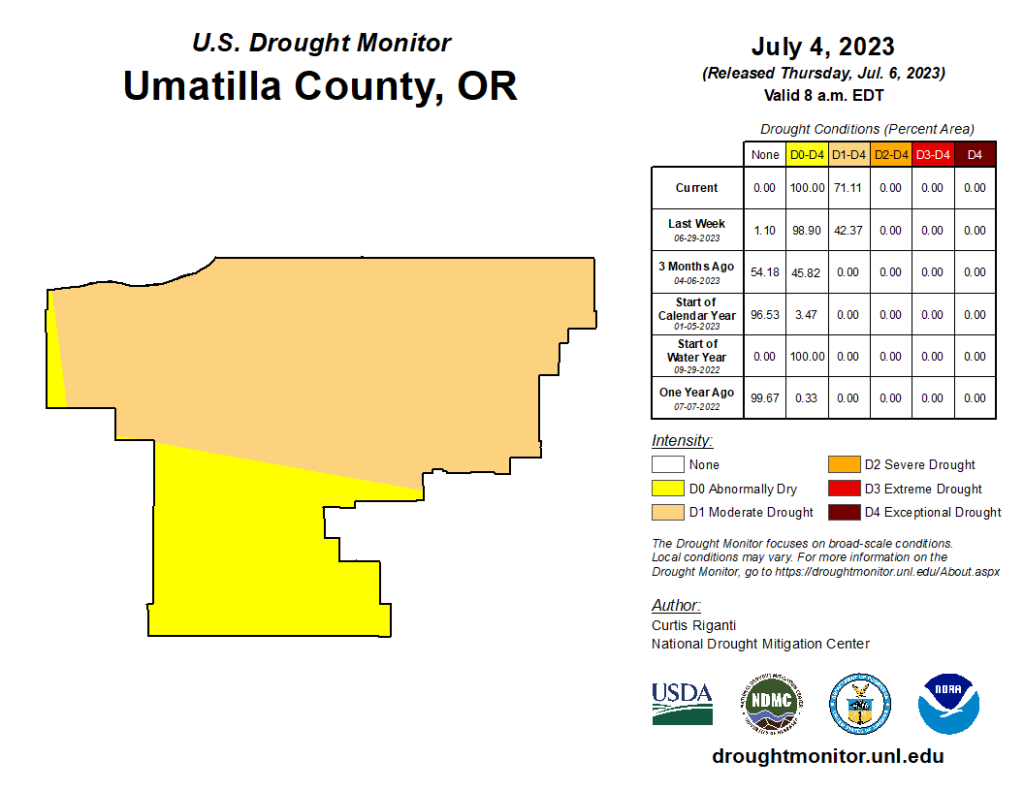Dryland crops are in distress
Published 11:29 am Thursday, July 20, 2023

- 20230704_county41059_trd.png
PENDLETON — We could argue whether or not the Columbia Basin is in a drought, based on definitions, said Don Wysocki, Oregon State University Extension soil scientist at Pendleton.
Trending
But one thing is certain, he said — dryland crops are suffering from a lack of water.
“Plants are stressed because they do not have enough water to grow and mature properly,” Wysocki said.
Dryland crops by definition aren’t irrigated by sprinklers or other manmade sources, so they depend solely on precipitation. And that has been below average this whole growing season — since September 2022.
Trending
“Dryland farmers are at the mercy of what falls from the sky,” Wysocki said.
This spring and early summer, in particular, were dramatically drier than a year ago.
From Jan. 1 through June 30, 2022, precipitation at the Eastern Oregon Regional Airport in Pendleton totaled 10.82 inches.
This year the total for that six-month period was less than half as much — 4.45 inches.
The average for that period is 7.08 inches.
The difference was especially dramatic in May and June.
In May 2022, rainfall at the airport totaled 3.45 inches. This year’s total was a paltry 0.45 of an inch.
In June 2022 the airport recorded 2.16 inches, compared with this June’s barely noticable .07 of an inch.
“This will affect all crops,” Wysocki said, particularly green peas, canola, barley and wheat.
“All are suffering,” he said. “They are shorter than normal, and they are maturing sooner, too soon.”
He also said it is getting expensive to care for them, especially green peas.
With wheat in particular, Wysocki said, farmers would be fortunate to cut an average crop this year.
“Most will be below average, but it varies by location due to variation in rainfall,” he said. “Some crops got some precipitation while others didn’t get any. It’s local variation.”
Besides the lack of rainfall, temperatures have been generally above average in the basin since early May.
The average high temperature at the Eastern Oregon Regional Airport in May was 76.9 degrees — almost 6 degrees above average.
In June the average high was 83.4 degrees, which is almost 5 degrees above average.
Preparing for decreasing yields
Farmers can’t control precipitation, so they control what they can to prepare for the expected low yield from their fields.
“So farmers are controlling input costs, which might include the use of cheaper herbicides,” Wysocki said.
Another factor that can be controlled is less tillage, reducing costs and preserving what little moisture there is in the soil because tilling dries out the soil. However, Wysocki mentioned this is a practice that a lot of farmers already employ.
Unfortunately, Wysocki emphasized, “not all farmers want the same thing at the same time.” All want rain at some point, but timing is everything. Right now, it is rain that dryland farmers want and need.
Farmers who grow hay or harvest cherries, by contrast, don’t want deluges while their hay is curing or their cherries are ripening.
“Rain reduces the quality of hay, and it splits ripe cherries,” Wysocki said.
Planning for next year already is well underway.
“This year’s supply for water is for next year’s crops,” Wysocki said. “The hope is that it will rain in August right after harvest.”
“Plants are stressed because they do not have enough water to grow and mature properly.”
— Don Wysocki, Oregon State University Extension Service
The past two years had dramatically different first halves, in terms of rainfall, in the Columbia Basin.
Total precipitation (including rain and melted snow) measured at the Eastern Oregon Regional Airport in Pendleton was less than half as much from Jan. 1 through June 30, 2023, compared with the same period in 2022.
A month-by-month comparison:
January
• 2023: 0.61
• 2022: 1.53
February
• 2023: 0.72
• 2022: 0.91
March
• 2023: 0.89
• 2022: 1.16
April
• 2023: 1.71
• 2022: 2.02
May
• 2023: 0.45
• 2022: 3.45
June
• 2023: 0.07
• 2022: 2.16









